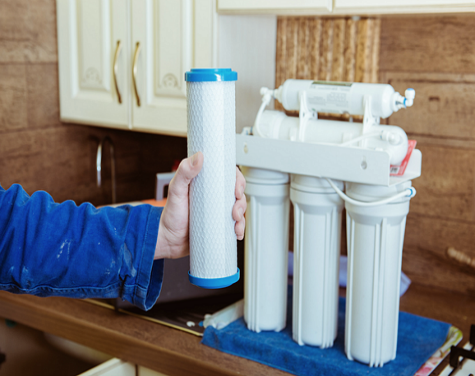How to Change Your Refrigerator Water Filter – The Complete Guide
Built-in water filters are some of the best features that refrigerators can have. They eliminate the need to buy separate water filters
There’s just one problem: what do you do when the water filter needs to be replaced? Are there any parts you need to buy? How do you access the filter in the first place?
If these are the problems plaguing you, you’ve come to the right place. Here’s everything you need to know about how to change refrigerator water filter.
How to Change Refrigerator Water Filter
Changing your refrigerator water filter is a simple process. However, there are multiple steps and a lot of variation. Following our suggested order will help you save time and avoid issues.
1. Locate Your Filter
Most water filters are located inside the refrigerator behind the icemaker of the freezer section or in the back corner of the actual fridge. They’re usually labeled, which makes them much easier to find. In older fridges, you might have to search in the grille at the bottom or base of your fridge.
Either way, there will be a visible knob or lever near the filter. All you have to do is push or press this knob or lever and the fridge will easily release the water filter for you to change.
2. Determine Your Filter Model
The replacement water filter you need will differ based on what type of fridge you have. Like all appliances, most fridge accessories are grouped by brand. As long as you can identify the brand that your refrigerator is, finding the specific part number should be easy.
It’s also worth noting that, unless the number has worn way, most water filters have their part number etched into the side.
If you still aren’t sure which type you need, there are plenty of online resources to help you determine the filter you need. Just type in the number on the filter or browse by refrigerator brands.
3. Discard the Old Filter
Once you’ve determined the filter part number from your old filter, it’s time to discard it. This can be as simple as tossing it into the trash or plastic recycling bin, but you also have another option. Depending on your fridge brand, you might also be able to return it to the manufacturer for them to recycle.
4. Install the New Filter
The installation process can go one of two ways: twisting or pushing. It’s easy to tell which method you’ll be using based on the way that you ejected your old water filter.
For twist-in filters, lineup the replacement filter with the threads and gently turn it clockwise. You may hear a snap when it’s fully in place. Another indicator new refrigerators have is the “Reset Filter” light. This light will either change from red to green or light up from being off entirely.
Push-in filters have directional arrows printed on the sides. Just line these up with the arrows in the filter itself and push it in until it clicks or snaps. You should also notice that the ejector button or lever returns to its initial position. If you have a newer fridge and the “Reset Filter” light didn’t change, you may want to twist the cap at the back of the replacement filter to ensure that it’s properly tightened.
5. Test Your Water
After installation is complete, just grab an empty cup or bottle and test out the new water filter. You may hear whirring or spinning for a few seconds before any water comes out. When it does, all you have to do is examine it for obvious particles and/or discoloration. If it looks perfectly clear, you’re good to go!
If you want to be really thorough, you can also test your water’s pH. pH test strips are fairly cheap, and you can buy them at most retailers. Water pH should fall between 6.5 and 8.5. The closer it is to 7.0, the better.
Importance of Replacing Fridge Water Filter
Now that you know how to change your fridge filter, let’s talk about why it’s important.
Tap water—which is what your fridge would release without a filter—isn’t terribly dangerous. The Environmental Protection Agency (EPA) and local utility districts both have specifications that water quality must meet before that water reaches your house. However, the unpleasant truth is that these specifications don’t protect you from everything you think it does.
Tap water often contains metal that has eroded from the water pipes. Lead is the most common of these metals. In minuscule doses, lead is harmless. Drinking too much of it, though, can lead to lead poisoning. Symptoms of lead poisoning include renal failure, cardiovascular problems, reproductive issues, and even lower IQ in developing fetuses and children.
Other contaminants like bacteria, unwanted chemicals, and even microscopic creatures like worms are far from uncommon in normal tap water.
The big takeaway here is that, no matter how safe you think your tap water is, it’s always a good idea to have another layer of filtration. Replacing your refrigerator water filter is an excellent first step in ensuring this.
More from Two Classy Chics
Do you want to know how to get those pesky stains out of your white pants? Is it time to upgrade your foundation? Are you confused about more than just how to change refrigerator water filter?
Never fear! Two Classy Chics is here to make your life easier. Check out the rest of our blog for all the lifehacks you’ll ever need.
